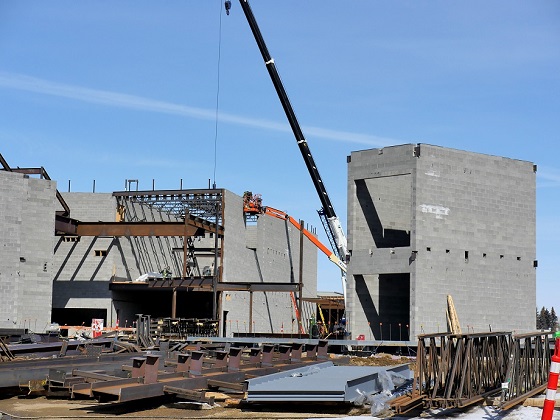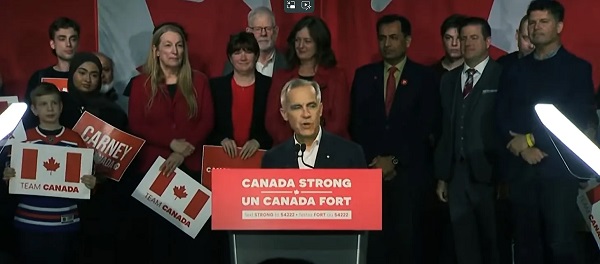Alberta
$8.6 billion committed: Province to fund up to 30 new schools and 8 modernizations in each of next 3 years

Alberta’s government is committing $8.6 billion to complete and open 200,000 new student spaces across the province in the next seven years.
Alberta’s population is growing exponentially as more people from across Canada and around the world choose to make the province their home. This rapid growth is causing strain on the Kindergarten to Grade 12 education system, with student enrolment increasing at historic rates.
To keep up with fast-rising student enrolment, Alberta’s government is committing $8.6 billion through the new School Construction Accelerator Program. This program will create more than 200,000 new and modernized spaces for students to learn, grow and reach their full potential. Starting in Budget 2025, Alberta’s government will kick-start up to 30 new schools and as many as eight modernizations and replacement schools every year for the next three years.
“Every student deserves a quality education in a school that can meet their learning needs and set them on a path to success in the future. As hundreds of thousands of people are choosing to make Alberta their home, we are responding by funding and building the schools our fast-growing communities need. As we build, we’re asking school boards and municipalities to work with us so we can get shovels in the ground as quickly as possible.”
The Calgary Metropolitan Area and Edmonton Metropolitan Region, along with other communities across the province, have been feeling the pressures of strong student growth and aging school infrastructure. The School Construction Accelerator Program will result in 50,000 new or modernized student spaces over the next three years – and more than 150,000 new and modernized spaces over the following four years. In total, the School Construction Accelerator Program will mean approval for up to 30 new school projects and as many as eight new modernization and replacement projects every year over the next three years. In addition to the school projects, 20,000 new student spaces will be delivered through modular classrooms over the next four years.
“We are investing in the future of our province. Through our commitment to kick-start 30 new schools each year over the next three years, we are delivering new student spaces across the province and in our fastest-growing communities for students to learn, grow and reach their full potential.”
“I look forward to working with my ministry and industry partners to build the schools Albertans need and ensuring that each project is as unique as the students who use them. School builds, modernizations and renovations support tens of thousands of jobs across the province. As Alberta communities continue to grow, this announcement will allow us to meet demands for spaces faster and more efficiently, all while creating jobs and boosting our local and provincial economies.”
The School Construction Accelerator program also takes immediate action to speed up the construction of schools by enabling school projects to be approved in-year for their next stage in the construction process without having to wait for the next budget cycle. This means all previously approved school projects currently in the planning and design stages can move forward to the next stage as soon as they are ready to do so. Through this change, 10 previously announced priority school projects are now approved for the next stage of project delivery, including six moving to full construction.
“We appreciate the government’s recognition that there is an urgent need to provide additional learning spaces for CBE students. CBE families are looking forward to new schools in their growing communities and modernizations to address aging infrastructure. Thank you to the Premier and the Government of Alberta for this much-needed investment.”
“Edmonton Public Schools is grateful for the province’s funding for school infrastructure. This crucial support will help us meet urgent needs and positively affect our students and families.”
The population growth has not only increased pressure in the public and separate school system but has increased demand for publicly funded charter programming and space needs. Public charter schools play an important role in Alberta’s education system by offering unique programming to students focused on a learning style, teaching style, approach or pedagogy not already being offered by school boards where the charter is located. As part of this accelerated program, Alberta’s government will add 12,500 new charter school student spaces over the next four years through a Charter School Accelerator pilot program.
“The Association of Alberta Public Charter Schools is elated by this historic capital announcement. It will help ensure that more families and students can access the excellent programming our public charter schools offer for generations to come.”
Independent schools offer specialized learning supports as well as religious and cultural programming to support parental and educational choice. Alberta’s government will continue to explore opportunities for a school capital pilot program for non-profit independent schools to broaden learning options for Alberta families.
Quick facts
- The School Construction Accelerator Program will deliver more than 200,000 new and modernized student spaces.
- Previously approved school projects and modular classrooms will create about 50,000 new and modernized student spaces over the next three years.
- The program will create about 150,000 additional new and modernized student spaces. This includes:
- more than 100,000 new student spaces
- more than 16,600 modernized student spaces
- more than 20,000 student spaces in new or relocated modular classrooms
Alberta
Made in Alberta! Province makes it easier to support local products with Buy Local program

Show your Alberta side. Buy Local. |
When the going gets tough, Albertans stick together. That’s why Alberta’s government is launching a new campaign to benefit hard-working Albertans.
Global uncertainty is threatening the livelihoods of hard-working Alberta farmers, ranchers, processors and their families. The ‘Buy Local’ campaign, recently launched by Alberta’s government, encourages consumers to eat, drink and buy local to show our unified support for the province’s agriculture and food industry.
The government’s ‘Buy Local’ campaign encourages consumers to buy products from Alberta’s hard-working farmers, ranchers and food processors that produce safe, nutritious food for Albertans, Canadians and the world.
“It’s time to let these hard-working Albertans know we have their back. Now, more than ever, we need to shop local and buy made-in-Alberta products. The next time you are grocery shopping or go out for dinner or a drink with your friends or family, support local to demonstrate your Alberta pride. We are pleased tariffs don’t impact the ag industry right now and will keep advocating for our ag industry.”
Alberta’s government supports consumer choice. We are providing tools to help folks easily identify Alberta- and Canadian-made foods and products. Choosing local products keeps Albertans’ hard-earned dollars in our province. Whether it is farm-fresh vegetables, potatoes, honey, craft beer, frozen food or our world-renowned beef, Alberta has an abundance of fresh foods produced right on our doorstep.
Quick facts
- This summer, Albertans can support local at more than 150 farmers’ markets across the province and meet the folks who make, bake and grow our food.
- In March 2023, the Alberta government launched the ‘Made in Alberta’ voluntary food and beverage labelling program to support local agriculture and food sectors.
- Through direct connections with processors, the program has created the momentum to continue expanding consumer awareness about the ‘Made in Alberta’ label to help shoppers quickly identify foods and beverages produced in our province.
- Made in Alberta product catalogue website
Related information
Alberta
Province to expand services provided by Alberta Sheriffs: New policing option for municipalities

Expanding municipal police service options |
Proposed amendments would help ensure Alberta’s evolving public safety needs are met while also giving municipalities more options for local policing.
As first announced with the introduction of the Public Safety Statutes Amendment Act, 2024, Alberta’s government is considering creating a new independent agency police service to assume the police-like duties currently performed by Alberta Sheriffs. If passed, Bill 49 would lay additional groundwork for the new police service.
Proposed amendments to the Police Act recognize the unique challenges faced by different communities and seek to empower local governments to adopt strategies that effectively respond to their specific safety concerns, enhancing overall public safety across the province.
If passed, Bill 49 would specify that the new agency would be a Crown corporation with an independent board of directors to oversee its day-to-day operations. The new agency would be operationally independent from the government, consistent with all police services in Alberta. Unlike the Alberta Sheriffs, officers in the new police service would be directly employed by the police service rather than by the government.
“With this bill, we are taking the necessary steps to address the unique public safety concerns in communities across Alberta. As we work towards creating an independent agency police service, we are providing an essential component of Alberta’s police framework for years to come. Our aim is for the new agency is to ensure that Albertans are safe in their communities and receive the best possible service when they need it most.”
Additional amendments would allow municipalities to select the new agency as their local police service once it becomes fully operational and the necessary standards, capacity and frameworks are in place. Alberta’s government is committed to ensuring the new agency works collaboratively with all police services to meet the province’s evolving public safety needs and improve law enforcement response times, particularly in rural communities. While the RCMP would remain the official provincial police service, municipalities would have a new option for their local policing needs.
Once established, the agency would strengthen Alberta’s existing policing model and complement the province’s current police services, which include the RCMP, Indigenous police services and municipal police. It would help fill gaps and ensure law enforcement resources are deployed efficiently across the province.
Related information
-

 2025 Federal Election2 days ago
2025 Federal Election2 days agoASK YOURSELF! – Can Canada Endure, or Afford the Economic Stagnation of Carney’s Costly Climate Vision?
-

 Alberta2 days ago
Alberta2 days agoMade in Alberta! Province makes it easier to support local products with Buy Local program
-

 2025 Federal Election22 hours ago
2025 Federal Election22 hours agoEuthanasia is out of control in Canada, but nobody is talking about it on the campaign trail
-

 2025 Federal Election9 hours ago
2025 Federal Election9 hours agoMEI-Ipsos poll: 56 per cent of Canadians support increasing access to non-governmental healthcare providers
-

 2025 Federal Election17 hours ago
2025 Federal Election17 hours agoAI-Driven Election Interference from China, Russia, and Iran Expected, Canadian Security Officials Warn
-

 2025 Federal Election2 days ago
2025 Federal Election2 days agoCSIS Warned Beijing Would Brand Conservatives as Trumpian. Now Carney’s Campaign Is Doing It.
-

 2025 Federal Election2 days ago
2025 Federal Election2 days agoInside Buttongate: How the Liberal Swamp Tried to Smear the Conservative Movement — and Got Exposed
-

 illegal immigration1 day ago
illegal immigration1 day agoDespite court rulings, the Trump Administration shows no interest in helping Abrego Garcia return to the U.S.






